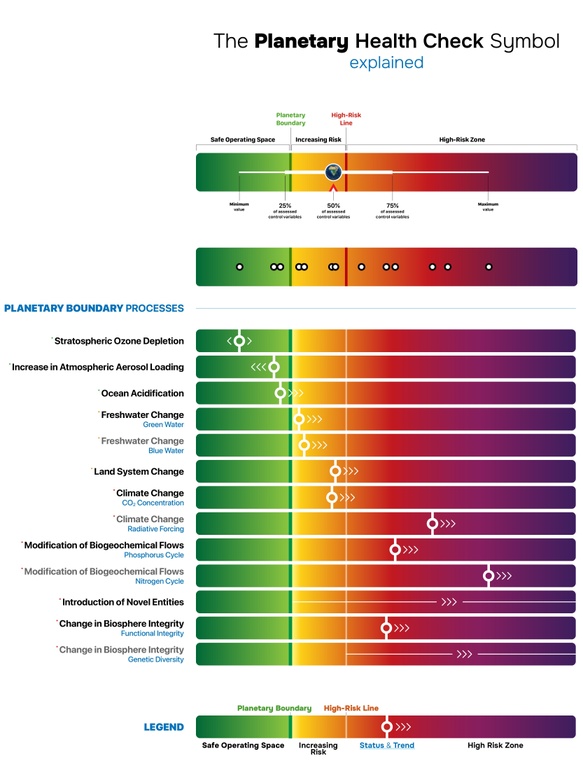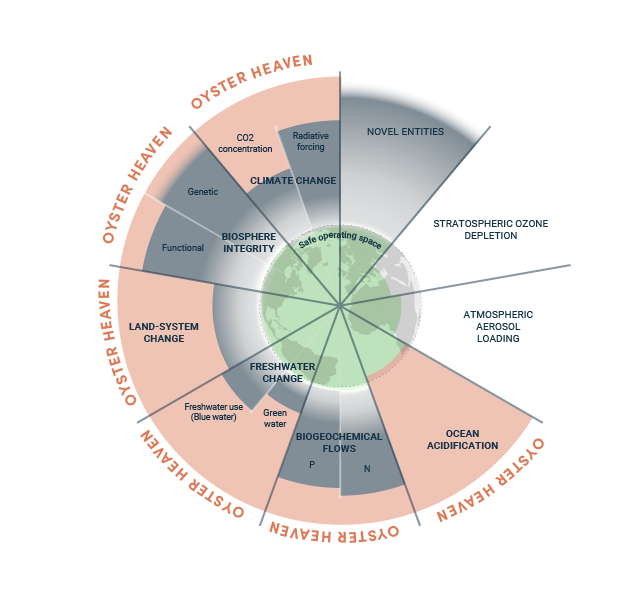
The concept of planetary boundaries, introduced by scientists in 2009, outlines nine critical limits within which humanity can safely operate to maintain Earth’s stability.
“ Once a boundary is breached, the risk of permanently damaging Earth’s life support functions increases as does the probability of crossing tipping points that cause irreversible changes. If multiple boundaries are breached, risks sharply increase.” – Potsdam Institute for Climate Impact Research

The 9 Planetary Boundaries are:
All Planetary Boundary processes act together, and each one needs protection to safeguard the whole system. Crossing these boundaries risks triggering irreversible environmental damage, threatening ecosystems and human societies alike.
According to the latest findings from the Potsdam Institute for Climate Impact Research (PIK), Earth may have already breached seven of these boundaries, with ocean acidification now dangerously close to exceeding its safe limit.

This alarming news serves as a wake-up call to the fragile state of our planet’s marine ecosystems. Ocean acidification, driven by increased carbon dioxide emissions and the continuous release of untreated sewage into the ocean, is accelerating at an unprecedented rate.
As CO₂ is absorbed by the ocean, it lowers the pH of seawater, making it more acidic. This process poses a serious threat to marine life, particularly species that rely on calcium carbonate to form their shells and skeletons—such as oysters, corals, and certain plankton species.
The PIK’s recent findings underscore the urgency of addressing ocean acidification and the broader issue of planetary boundary breaches. If current trends continue, the resilience of marine ecosystems will be further compromised, with long-lasting consequences for global biodiversity and human livelihoods, particularly those dependent on fisheries and coastal protection.
Environmental challenges tend to be addressed separately, but as we often emphasise, everything in nature is interconnected.
The case of the Great Barrier Reef in Australia illustrates the impact of crossing planetary boundaries: once a thriving ecosystem home to thousands of marine species, it has experienced severe coral bleaching events in recent years due to rising ocean temperatures and increased ocean acidification. The acidic waters weaken the corals’ ability to produce calcium carbonate, essential for their growth and resilience. This disruption has led to a decline in biodiversity, affecting species that depend on the reef for shelter and food and the livelihoods of communities that depend on them.
As we can see, the disruption of one Earth system process will inevitably affect the others. Therefore, issues such as climate change, biodiversity loss and ocean acidification should be addressed collectively rather than individually.

At Oyster Heaven, we are tackling these challenges by restoring oyster reefs at scale – a vital solution for the health of marine ecosystems. Restoration of these habitats tackles many of these issues simultaneously: oyster reefs help mitigate ocean acidification while also supporting biodiversity, carbon sequestration and the regulation of biochemical flows, indirectly having a positive impact on other Earth system processes.
In this other blog, we explain more about our approach to rewilding the ocean and why restoring oyster reefs is a holistic solution to help nature return to its original state. Bringing balance to the ocean will trigger a domino effect that helps reduce the worrying levels of several planetary boundaries simultaneously.

Make a measurable difference for the ocean today.
You can now adopt a Mother Reef and help restore 100 oysters!

